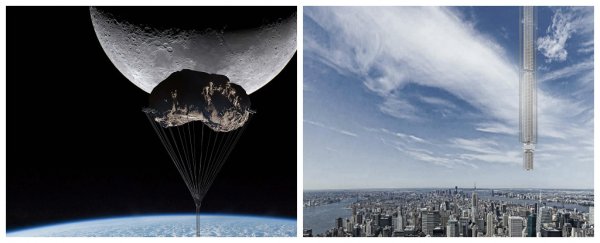If you thought that ridiculous U-shaped skyscraper proposed for Manhattan earlier this week was all kinds of crazy, we've already found a group of architects that want to take this madness to the next level.
Instead of planting our buildings safely on the ground where they belong, why not strap one to a wandering asteroid and hang it over the city like a roving deathtrap of epic proportions?
That's the proposal from New York-based design firm, the Clouds Architecture Office, which has put together an elaborate set of concept art to help us visualise what the future of cities might look like - if we manage to hit the right level on the Kardashev scale of technological advancement, that is.
But wait, how do people exit a building that's suspended tens of thousands of kilometres above Earth?
Oh, parachutes:
 Clouds Architecture Office
Clouds Architecture Office
Don't worry, the Clouds Architecture Office has actually put more thought into this so-proclaimed "speculative" project than you might expect, reasoning that asteroid manipulation is no longer restricted to the realm of science fiction.
"In 2015, the European Space Agency sparked a new round of investment in asteroid mining … by proving with its Rosetta mission that it's possible to rendezvous and land on a spinning comet," they explain on their website.
"NASA has scheduled an asteroid retrieval mission for 2021, which aims to prove the feasibility of capturing and relocating an asteroid."
That's all well and good, but let's not forget that other NASA research project from late 2016, which found that Earth is woefully unprepared for a surprise asteroid strike, specifically because it's so incredibly difficult to manipulate an asteroid.
Technicalities aside, the so-called Analemma Tower would be placed in a geosynchronous orbit, which is an orbit that perfectly matches Earth's rotation on its axis.
So for an observer on the surface, the skyscraper would return to exactly the same position in the sky after approximately 23 hours 56 minutes and 4 seconds.
According to the architects, that would allow it to travel between the Northern and Southern Hemispheres on a daily loop.
"The ground trace for this pendulum tower would be a figure eight, where the tower would move at its slowest speed at the top and bottom of the figure eight, allowing the possibility for the towers occupants to interface with the planet's surface at these points," the group explains.
"The proposed orbit is calibrated so the slowest part of the towers trajectory occurs over New York City."
 Clouds Architecture Office
Clouds Architecture Office
The skyscraper would be suspended from an asteroid orbiting Earth at 50,000 km (31,068 miles) above the surface. The building itself would be positioned roughly 32 km (20 miles) above the surface.
The problem here is that humans don't do so well at such altitudes - as the team explains, the near vacuum and -40°C (-40°F) temperature would require protective suits when visitors are entering and leaving the building.
Of course, something like this is likely never going to happen, but in a world where dreams of the future are going to have to be a whole lot bigger than flying cars and hoverboards, floating buildings aren't such a bad idea.
Plus someone's got to consider what civilisations far more advanced than ours could be capable of achieving - scientists have already been doing that recently when it comes to mystery fast radio bursts and that notorious 'alien megastructure' star.
And if the best thing to come from this is that someone makes a Fifth Element sequel full of these things - that would be awesome.
Here's a pretty cool infographic to give you an idea of the scale they're proposing:
 Clouds Architecture Office
Clouds Architecture Office
